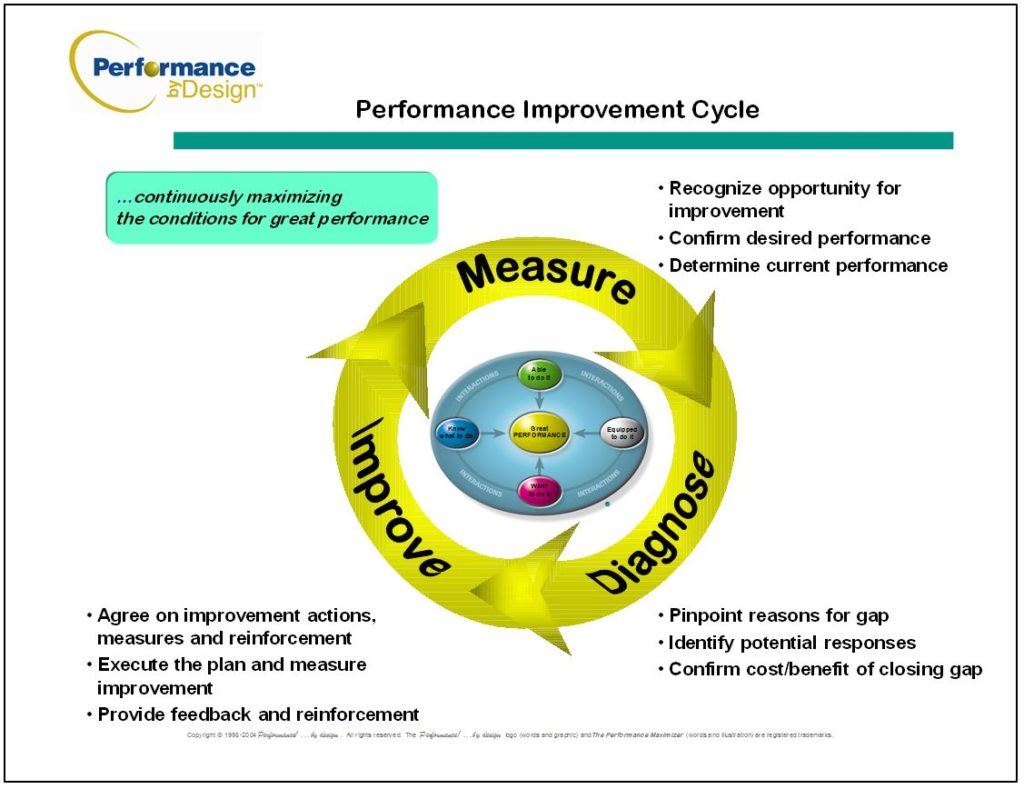Welcome back to our 4-Part Series: Escaping the Performance Management Trap.
MEASURE – DIAGNOSE – IMPROVE
As we recall in Part 2A, ConvenientStop is re-organizing, implementing a new business strategy and changing some roles, all at a time when they are experiencing falling profits and unhappy Retail Store Managers who do not feel that their retail locations are receiving the required support.
In this segment we will be introducing a model called the Performance Improvement Cycle: Measure – Diagnose – Improve. We will be applying this model as we explore the experience of John Smith, a Merchandising Representative at ConvenientStop.
The Merchandising Representatives at ConvenientStop are the crucial link to the success of their business results and those of the retail locations that they serve. The following outlines a brief summary of the performance that is expected of John in his role:
I do … (actions)
|
I achieve …. (job outputs)
|
I contribute to…. (business results)
|
Acknowledge need for improvement: John is frustrated. In the past he was very successful at getting positive feedback from the Retail Store Managers and his Regional Manager. Now he also sees that the retail location’s customers in his territory are grumbling about their staff not being knowledgeable or helpful. John is having scheduling problems, and he is no longer being included in the business planning of his customers.
Confirm desired performance: John’s Regional Manager has confirmed that he continues to be accountable for a target of 90% retail store satisfaction, inventory is always available for high volume products, and that high product awareness and knowledge is developed and maintained. The metrics of success are determined from periodic consumer surveys and customer feedback.
Clarify current performance:
John is doing well with….
- New product introductions and maintaining the appropriate inventory on shelves
- Designing and coordinating in-store displays and promotions in an effective and timely manner
- Training retail location staff on ConvenientStop products. The training role intimidates him and he does not deliver the training in an effective way, and he avoids it when possible
- Getting clarity of what is expected from his direct customers, the Retail Store Mangers, about the retail store objectives
- John does not have sufficient competency to deliver training
- Point-of-sale material is often late and delivered to the wrong place – John frequently spends an additional 4 hours per week sorting this out
- The current Sales Record System is outdated and cumbersome to use. John often spends his evening hours doing manual entries and maintenance
- John does not get data about retail store business plans
The diagnosis identified barriers to John’s performance in 4 out of the 5 areas of the Conditions for Great Performance that we introduced in Part 1: Understanding Performance. Those are:
- Know what to do (the lack of knowledge about the retail location’s business plans)
- Able to do it (John’s lack of skill in providing training)
- Equipped to do it (ConvenientStop’s point-of-sale material, Sales Record System, and lack of data about the retail store business plans
- Interactions (not effectively communicating with peers and colleagues)
Note: Condition #4) Willing to do it, is not a challenge for John or his Regional Manager as he displays keen interest and enjoyment in his job.
Identify potential response/actions:
Following some planning discussions, John and his Regional Manager have put the following plans into action that will address the immediate issues. These improvement strategies are expected to be noticeably improved within 90 days.
Regional Manager action:
- Rectify point-of-sale delivery problems with Marketing; this will save John the 4 hours/week to focus on high impact areas
- Develop his training skills; request help from other skilled trainers or his Regional Manager to assist with training at the retail locations
- John and the Regional Manager will meet to determine the specific actions and job outputs required of John to coordinate with the retail store location’s business plans
- John will set up regular meetings with his advisors to communicate his planning strategies and obtain feedback about the progress of the retail stores. The Regional Manager will be invited to join in some meetings to stay up to date
- John will conduct product knowledge sessions for staff in the retail stores 3 times per week
- Speed up the development of the new Sales Records System
Execute the plan and develop clear measures to evaluate success
Obtain feedback and reinforcement

